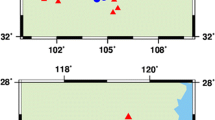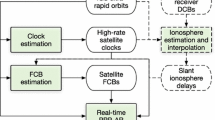Abstract
Rapid ambiguity resolution in precise point positioning (PPP-AR) has constantly been a difficulty preventing efficient initializations of user solutions. A successful initialization normally requires a few tens of minutes if only GPS data are processed, but can be accelerated significantly by integrating a second GNSS to both enhance the satellite geometry for faster ambiguity convergence and double the ambiguity quantity for higher partial-AR success rates. However, each GNSS asks for its own reference satellite to form resolvable ambiguities, namely intra-system PPP-AR. We propose to estimate station-specific inter-system phase biases (ISPBs) and then form resolvable ambiguities between, instead of within, GNSS (i.e., inter-system PPP-AR) aiming at providing one more ambiguity candidate for more efficient partial AR. We use 24 days of 5-s GPS/BeiDou data from 47 stations in China spanning an area of roughly 2000\(\times \)2000 km to carry out both intra- and inter-GPS/BeiDou PPP-AR. We find that about 85% of ISPBs vary minimally within 0.05 cycles from day to day, favoring precise predictions for real-time PPP-AR, despite the rare subdaily ISPB anomalies of up to 0.1 cycles and abrupt jumps of up to 0.3 cycles at a few stations. From hourly kinematic solutions, we find that 42.3% of them can be initialized successfully within 5 min in case of inter-GPS/BeiDou PPP-AR in contrast to only 29.7% in case of intra-GPS/BeiDou. The mean initialization time is therefore reduced appreciably from 649 to 586 s. This 10% improvement, though minor, is reasonable and still encouraging on account of the fact that only one extra resolvable ambiguity is contributed during the transition from intra- to inter-GPS/BeiDou PPP-AR, while both actually have the same model strength. Moreover, we provide a preliminary theoretical framework to implement inter-GNSS or tightly coupled GNSS models which can be extended to other multi-GNSS analysis.







Similar content being viewed by others
References
Boehm J, Niell AE, Tregoning P, Schuh H (2006) The Global Mapping Function (GMF): a new empirical mapping function based on data from numerical weather model data. Geophys Res Lett 33:L07304. https://doi.org/10.1029/2005GL025546
Dong D, Bock Y (1989) Global positioning system network analysis with phase ambiguity resolution applied to crustal deformation studies in California. J Geophys Res 94(B4):3949–3966
Euler HJ, Schaffrin B (1990) On a measure of the discernibility between different ambiguity solutions in the static-kinematic GPS mode. In: Schwarz KP, Lachapelle G (eds) Kinematic systems in geodesy. Surveying and remote sensing. Springer, New York, pp 285–295
Gao W, Gao C, Pan S, Meng X, Xia Y (2017) Inter-system differencing between GPS and BDS for medium-baseline RTK positioning. Remote Sens 9:948. https://doi.org/10.3390/rs9090948
Garcia-Serrano C, Springer T, Dilssner F, Flohrer C, Schönemann E, Enderle W (2016) ESOC’s multi-GNSS processing. In: IGS Workshop 2016, Sydney, Australia. 8-12 Feb
Ge M, Gendt G, Rothacher M, Shi C, Liu J (2008) Resolution of GPS carrier-phase ambiguities in precise point positioning (PPP) with daily observations. J Geod 82(7):389–399
Geng J, Bock Y (2013) Triple-frequency GPS precise point positioning with rapid ambiguity resolution. J Geod 87(5):449–460
Geng J, Shi C (2017) Rapid initialization of real-time PPP by resolving undifferenced GPS and GLONASS ambiguities simultaneously. J Geod 91(4):361–374
Geng J, Meng X, Dodson AH, Ge M, Teferle FN (2010) Rapid re-convergences to ambiguity-fixed solutions in precise point positioning. J Geod 84(12):705–714
Geng J, Teferle FN, Meng X, Dodson AH (2011) Towards PPP-RTK: ambiguity resolution in real-time precise point positioning. Adv Space Res 47(10):1664–1673
Geng J, Shi C, Ge M, Dodson AH, Lou Y, Zhao Q, Liu J (2012) Improving the estimation of fractional-cycle biases for ambiguity resolution in precise point positioning. J Geod 86(8):579–589
Julien O, Alves P, Cannon ME, Zhang W (2003) A tightly coupled GPS/Galileo combination for improved ambiguity resolution. In: Proceedings of the ENC GNSS 2003, Graz, Austria
Khodabandeh A, Teunissen PJG (2016) PPP-RTK and inter-system biases: the ISB look-up table as a means to support multi-system PPP-RTK. J Geod 90(9):837–851
Li P, Zhang X, Guo F (2017) Ambiguity resolved precise point positioning with GPS and BeiDou. J Geod 91(1):25–40
Liu Y, Lou Y, Ye S, Zhang R, Song W, Zhang X, Li Q (2017) Assessment of PPP integer ambiguity resolution using GPS, GLONASS and BeiDou (IGSO, MEO) constellations. GPS Solut 21(4):1647–1659
Melbourne WG (1985) The case for ranging in GPS-based geodetic systems. In: Proceedings of first international symposium on precise positioning with the global positioning system, Rockville, MD, pp 373–386
Montenbruck O, Steigenberger P, Hauschild A (2015) Broadcast versus precise ephemerides: a multi-GNSS perspective. GPS Solut 19(2):321–333
Odijk D, Teunissen PJG (2013) Characterization of between-receiver GPS-Galileo inter-system biases and their effect on mixed ambiguity resolution. GPS Solut 17(4):521–533
Odijk D, Nadarajah N, Zaminpardaz S, Teunissen PJG (2017) GPS, Galileo, QZSS and IRNSS differential ISBs: estimation and application. GPS Solut 21(2):439–450
Paziewski J, Wielgosz P (2015) Accounting for Galileo-GPS inter-system biases in precise satellite positioning. J Geod 89(1):81–93
Paziewski J, Wielgosz P (2017) Investigation of some selected strategies for multi-GNSS instantaneous RTK positioning. Adv Space Res 59(1):12–23
Petit G, Luzum B (eds) (2010) IERS Conventions (2010). Verlag des Bundes für Kartographie und Geodäsie, Frankfurt am Main, Germany, p 179
Schmid R, Dach R, Collilieux X, Jäggi A, Schmitz M, Dilssner F (2016) Absolute IGS antenna phase center model igs08.atx: status and potential improvements. J Geod 90(4):343–364
Teunissen P, Joosten P, Tiberius C (1999) Geometry-free ambiguity success rates in case of partial fixing. In: Proceedings of the 1999 National Technical Meeting of The Institute of Navigation, San Diego, CA, pp 201–207
Teunissen PJG (1995) The least-squares ambiguity decorrelation adjustment: a method for fast GPS integer ambiguity estimation. J Geod 70(1–2):65–82
Teunissen PJG, Khodabandeh A (2015) Review and principles of PPP-RTK methods. J Geod 89(3):217–240
Wanninger L, Beer S (2015) BeiDou satellite-induced code pseudorange variations: diagnosis and therapy. GPS Solut 19(4):639–648
Wu JT, Wu SC, Hajj GA, Bertiger WI, Lichten SM (1993) Effects of antenna orientation on GPS carrier phase. Manuscr Geod 18(2):91–98
Wübbena G (1985) Software developments for geodetic positioning with GPS using TI-4100 code and carrier measurements. In: Proceedings of first international symposium on precise positioning with the global positioning system, Rockville, MD, pp 403–412
Wübbena G, Schmitz M, Bagge A (2005) PPP-RTK: Precise point positioning using state-space representation in RTK networks. In: Proceedings of ION GNSS 18th International Technical Meeting of the Satellite Division, Long Beach, US, pp 2584–2594
Zumberge JF, Heflin MB, Jefferson DC, Watkins MM, Webb FH (1997) Precise point positioning for the efficient and robust analysis of GPS data from large networks. J Geophys Res 102(B3):5005–5017
Acknowledgements
This work is funded by National Science Foundation of China (41674033), China Earthquake Instrument Development Project (Y201707) and State Key Research and Development Programme (2016YFB0501802). We are grateful to IGS, NBASS (National BDS Augmentation Service System), CMONOC (Crustal Movement Observation Network of China) and Curtin University (saegnss2.curtin.edu.au/ldc) for the GPS/BeiDou data and the high-quality orbit, clock and ERP products. We thank the high-performance computing facility at Wuhan University where all computational works of this study were accomplished.
Author information
Authors and Affiliations
Corresponding author
Rights and permissions
About this article
Cite this article
Geng, J., Li, X., Zhao, Q. et al. Inter-system PPP ambiguity resolution between GPS and BeiDou for rapid initialization. J Geod 93, 383–398 (2019). https://doi.org/10.1007/s00190-018-1167-6
Received:
Accepted:
Published:
Issue Date:
DOI: https://doi.org/10.1007/s00190-018-1167-6




